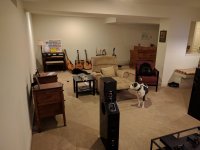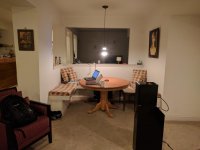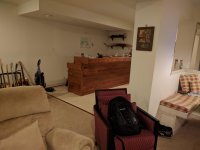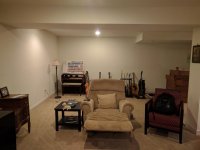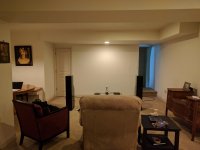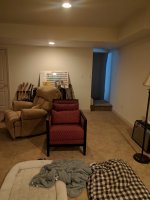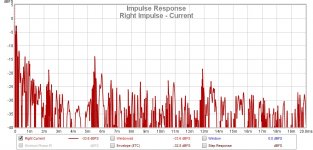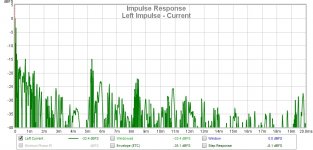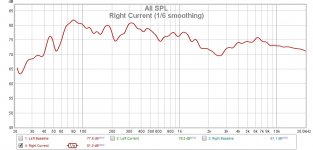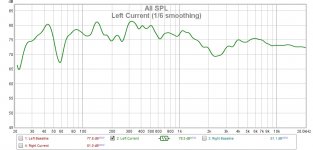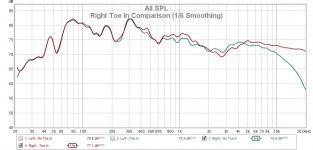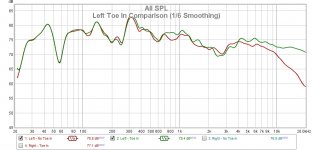Thanks, guys. I'll try covering the bar and seeing if that makes a difference. (This is part of the reason why I still have fiberglass that isn't covered or boxed - rather wait until it's finalized.)
krivium, how hard is to make the diffusors? Do I need to be really accurate in my measuremets? I do like the idea of putting them on the ceiling and was thinking of putting those on the rear wall.
allen, by steep angles towards the ceiling, do you mean situations where you are close to the speakers and the ceiling is relatively low so that the reflection angle is steep? and when you say my right speaker is pointing to the wall and the left is not, are you referring to the toe-in?
turk, I'm not sure about any of the construction as the basement (bar included) were all done by the previous owner. The subfloor is concrete, and the listening area is currently carpeted, and the area with the bar is tile (eventually want to replace with carpet). I imagine the bulkhead (both over the bar and on the ceiling just forward of my listening position) is ventilation and/or plumbing. The layout is rather odd due to these issues which is why I am using this end and not the other. I don't have any real clear choices, but I'll post pictures when I am back at the house.
and last but not least, scott - I wouldn't be surprised if that or something similar is what is going on. Last check (but five years ago), I was told I had good hearing. It could also be any of the above, mental (perhaps overstated), or equipment. For example, I switched the left and right speakers (tweeters aren't centered - slightly outward and now slightly inward with the change) and now the left doesn't sound as great but the right doesn't sound as bad...assuming again I'm not imaging or overstating the difference.
krivium, how hard is to make the diffusors? Do I need to be really accurate in my measuremets? I do like the idea of putting them on the ceiling and was thinking of putting those on the rear wall.
allen, by steep angles towards the ceiling, do you mean situations where you are close to the speakers and the ceiling is relatively low so that the reflection angle is steep? and when you say my right speaker is pointing to the wall and the left is not, are you referring to the toe-in?
turk, I'm not sure about any of the construction as the basement (bar included) were all done by the previous owner. The subfloor is concrete, and the listening area is currently carpeted, and the area with the bar is tile (eventually want to replace with carpet). I imagine the bulkhead (both over the bar and on the ceiling just forward of my listening position) is ventilation and/or plumbing. The layout is rather odd due to these issues which is why I am using this end and not the other. I don't have any real clear choices, but I'll post pictures when I am back at the house.
and last but not least, scott - I wouldn't be surprised if that or something similar is what is going on. Last check (but five years ago), I was told I had good hearing. It could also be any of the above, mental (perhaps overstated), or equipment. For example, I switched the left and right speakers (tweeters aren't centered - slightly outward and now slightly inward with the change) and now the left doesn't sound as great but the right doesn't sound as bad...assuming again I'm not imaging or overstating the difference.
Here are few more basement photos I found from back when I had the speakers set up on the other side...as you can see, there are lots of symmetry issues there, as well.
Attachments
Some guesses:
The dip for both speakers around 50-60 Hz is due to the distanse to the backwall, a guesstimate: 1,4 m / 4,6' (?). The difference in null frequency between L and R is probably because of the imbalance with the superchunk.
For frequences below about 50 Hz the left speaker gets more room gain than the right one, due to the proximity to the left wall. With lower frequnces the wavelength gets longer and more and more in phase with the direct sound, -so more room gain for left speaker in the lows.
A bit higher up in frequncy from roughly 60 Hz, the frontwall reflection gets more and more in phase with the direct sound. The superchunk isn’t very effective at very low frequencies but it increases as you go up in frequency which may be the reason why the left speaker show lower SPL from roughly 70-120 Hz, -as its additive frontwall reflection is damped down.
From 13-16 ms the impulse response show higher SPL for the right speaker. This is probably its left wall reflection and to shallow / insufficient resistive absorber at the wall. The left speaker is playing right out into air, so no reflections from it in the same time range.
The reflection in the 3-6 ms range are typically reflections from sidewall, floor and ceiling, depending on speaker distances to reflection areas. (= SBIR problems)
Personally I would consider:
1) skipping the superchunk
2) position the speakers close up to the front wall in a ”soft soffit” = if the speaker depth is 3 dm / 12” cover the whole frontwall with resistive asborbers of the the same depth. An air flow resistivity of around 5-10 kPa x s / m² should be suitable. You will still get a room gain in the low bass but have little problems with frontwall reflections if the resistive absorbtion goes up to the front of the speakers. An absorbing front wall may dampen the room to much. Wanted late and low SPL reflections speaker => backwall => frontwall => listening position adds ambience.
3) In that case, the frontwall could be built as a broadband helmholtz absorber. Check this post: Gearslutz - View Single Post - helmholz not very popular? The resistive absorbers behind the slats is Rockwool Flexibatts 9 kPa x s / m² and the the slat thicxkness 16 mm / 5/8”. Typical mode frequncies are damped but mid and high freqencies are not ”killed”.
4) Increase the thickness of the resistive absorber at the left wall to roughly 3 dm / 12” or more. At the mirror points from left and right speakers have about 0,6 m / 2’ width on each side of the mirror point and have only uncovered resitive absorber (cloth is OK of course). The rest of the wall could (also) be built into a low frequency broadband helmholtz absorber. If you want to be more ”surgical” than checking with a mirror, use the ETC in REW and use the ”string method ” and the extra length shown in the ETC to figure out more exactly the reflection area. -There’s little reason to kill the energy in the room with resistive asborbers at other places than the direct reflection areas for early reflections.
Edit. Above was written before your last pictures. Not an easy room ...
The dip for both speakers around 50-60 Hz is due to the distanse to the backwall, a guesstimate: 1,4 m / 4,6' (?). The difference in null frequency between L and R is probably because of the imbalance with the superchunk.
For frequences below about 50 Hz the left speaker gets more room gain than the right one, due to the proximity to the left wall. With lower frequnces the wavelength gets longer and more and more in phase with the direct sound, -so more room gain for left speaker in the lows.
A bit higher up in frequncy from roughly 60 Hz, the frontwall reflection gets more and more in phase with the direct sound. The superchunk isn’t very effective at very low frequencies but it increases as you go up in frequency which may be the reason why the left speaker show lower SPL from roughly 70-120 Hz, -as its additive frontwall reflection is damped down.
From 13-16 ms the impulse response show higher SPL for the right speaker. This is probably its left wall reflection and to shallow / insufficient resistive absorber at the wall. The left speaker is playing right out into air, so no reflections from it in the same time range.
The reflection in the 3-6 ms range are typically reflections from sidewall, floor and ceiling, depending on speaker distances to reflection areas. (= SBIR problems)
Personally I would consider:
1) skipping the superchunk
2) position the speakers close up to the front wall in a ”soft soffit” = if the speaker depth is 3 dm / 12” cover the whole frontwall with resistive asborbers of the the same depth. An air flow resistivity of around 5-10 kPa x s / m² should be suitable. You will still get a room gain in the low bass but have little problems with frontwall reflections if the resistive absorbtion goes up to the front of the speakers. An absorbing front wall may dampen the room to much. Wanted late and low SPL reflections speaker => backwall => frontwall => listening position adds ambience.
3) In that case, the frontwall could be built as a broadband helmholtz absorber. Check this post: Gearslutz - View Single Post - helmholz not very popular? The resistive absorbers behind the slats is Rockwool Flexibatts 9 kPa x s / m² and the the slat thicxkness 16 mm / 5/8”. Typical mode frequncies are damped but mid and high freqencies are not ”killed”.
4) Increase the thickness of the resistive absorber at the left wall to roughly 3 dm / 12” or more. At the mirror points from left and right speakers have about 0,6 m / 2’ width on each side of the mirror point and have only uncovered resitive absorber (cloth is OK of course). The rest of the wall could (also) be built into a low frequency broadband helmholtz absorber. If you want to be more ”surgical” than checking with a mirror, use the ETC in REW and use the ”string method ” and the extra length shown in the ETC to figure out more exactly the reflection area. -There’s little reason to kill the energy in the room with resistive asborbers at other places than the direct reflection areas for early reflections.
Edit. Above was written before your last pictures. Not an easy room ...
Last edited:
Without changing the ceiling, if you calculate the difference between the direct distance and the reflected distance it will be greater the closer you sit to your speakers.allen, by steep angles towards the ceiling, do you mean situations where you are close to the speakers and the ceiling is relatively low so that the reflection angle is steep?
My speakers are in corners pointing directly out of those corners. They are directional, being designed to be there. Their axes cross in front of where I sit. The opposite wall reflections are stronger than the near wall reflections. They are also different in nature.and when you say my right speaker is pointing to the wall and the left is not, are you referring to the toe-in?
Some guesses:
The dip for both speakers around 50-60 Hz is due to the distanse to the backwall, a guesstimate: 1,4 m / 4,6' (?). The difference in null frequency between L and R is probably because of the imbalance with the superchunk. ...
Spot on - the front of the tweeters are 5'11'' from the wall and the speakers are about 18'' (just a guess) long so the rear port is about 4.5 ft from the wall.
From 13-16 ms the impulse response show higher SPL for the right speaker. This is probably its left wall reflection and to shallow / insufficient resistive absorber at the wall. The left speaker is playing right out into air, so no reflections from it in the same time range. ...
I'm not sure what this is, and it may be something specific to room at the time of the measurement. I don't see it in the new measurements (will attach shortly), and the side wall reflection should be a little over 10ms. I saw that in my baseline and was able to reduce it with absorption.
The reflection in the 3-6 ms range are typically reflections from sidewall, floor and ceiling, depending on speaker distances to reflection areas. (= SBIR problems)...
Again, spot on. Since I'm so close to the speakers, the floor is around 1ms. Since it's carpet, I'm surprised to see it having as big a reflection as it does, but since it is such a short time frame, I wasn't planning on doing anything with it. The ceiling is around 5.5ms which you can see in the impulse response and matches the time I would expect to see it.
Given your comment regarding my room at the end of this, how much of this still applies? And what could I expect in terms of benefits? My primary motivation for setting up a listening room is instrument clarity. I like being able to pinpoint different instruments to a location and hearing them all interact together.Personally I would consider:...
1) skipping the superchunk...
Done - I just put that there for the time being. I removed it, and I haven't heard much difference, if any.
I removed it, and I haven't heard much difference, if any.
Bass work with absorbers is possible but benefits roll in only after using several times that amount of treatment.
Using an active room mode workaround is much more practical.
I removed the corner junk and put absorption around the 'cap' of the bar and didn't notice much of a difference. However, playing with speakers and set-up I did notice a few things. (I was planning on posting updated measurements, but I seem to have screwed up the l/r in my file names. Hope to do this later.)
Most importantly, I've got a better description of the issue by using Fleetwood Mac's Dreams as reference. The xylophones that kick in on the right hand side around the 50 sec mark sound ill-defined, and this gets worse as the volume gets higher. If I play it at a lower (but still decent) volume, I can regain the clarity, but I lose the positioning. Instead, it seems to hop from hard right to hard left. Switching the L/R puts this track about 45 degrees to my left with well defined position and good clarity.
Second, toe-in makes a huge difference at higher frequencies. The previous measurements were all taken with the speakers firing parallel to the side wall, but as you can see, the high frequency is much better when you adjust the toe-in.
I would assume so, but I don't know what to look for or what the impact might be. I imagine that both the bar and tile floor create problems, but I don't know what I'd look for. For example, since it does arrive so late and since it would have to have multiple reflections before getting back to me, I would assume the sound level is low so may not be apparent in any measurements.
Most importantly, I've got a better description of the issue by using Fleetwood Mac's Dreams as reference. The xylophones that kick in on the right hand side around the 50 sec mark sound ill-defined, and this gets worse as the volume gets higher. If I play it at a lower (but still decent) volume, I can regain the clarity, but I lose the positioning. Instead, it seems to hop from hard right to hard left. Switching the L/R puts this track about 45 degrees to my left with well defined position and good clarity.
Second, toe-in makes a huge difference at higher frequencies. The previous measurements were all taken with the speakers firing parallel to the side wall, but as you can see, the high frequency is much better when you adjust the toe-in.
But that open side of the listening area means very late reflections dosen't it? My living room is similar.
I would assume so, but I don't know what to look for or what the impact might be. I imagine that both the bar and tile floor create problems, but I don't know what I'd look for. For example, since it does arrive so late and since it would have to have multiple reflections before getting back to me, I would assume the sound level is low so may not be apparent in any measurements.
This is interesting. This may be showing elements of both room and speaker issues.The xylophones that kick in on the right hand side around the 50 sec mark sound ill-defined, and this gets worse as the volume gets higher. If I play it at a lower (but still decent) volume, I can regain the clarity, but I lose the positioning. Instead, it seems to hop from hard right to hard left.
If your room wasn't asymmetric I'd think this was odd compared to the other side and wonder whether your cables had been sitting long before you did the swap.Switching the L/R puts this track about 45 degrees to my left with well defined position and good clarity.
I wonder how the speakers would perform if you took them outside for the track, or maybe just listened to them even closer.
Perhaps you can set a sub-goal in working on just the frequencies within the purvue of your existing absorbers, and try to attenuate all reflections within 10mS or so.
Yes, that's what I was thinking. Since those reflections are late and multiple, they should not give you anything like the sound from that near wall.For example, since it does arrive so late and since it would have to have multiple reflections before getting back to me, I would assume the sound level is low so may not be apparent in any measurements.
It will be interesting to see your measurements. Someone here will be able to tease out the offending reflections and cancellations. And since you can hear it so well on the xylophone part - it might be worth a quick analysis of that frequency range.
Snip ...My primary motivation for setting up a listening room is instrument clarity. I like being able to pinpoint different instruments to a location and hearing them all interact together.
Snip
Soundstage clarity / pinpointing of instruments will increase if you take the room’s influence out of the equation. The subtractive interference dip around 50-60 Hz is not on the recording, it is caused by SBIR, a reflection from the wall behind the speakers. At a higher frequency one can expect a constructive interference, a boost, also because of SBIR. These may not be exact multiples but fairly close to each other. Cure can be flush mounted speakers into a rigid wall or moving the speakers right up against the frontwall. The dip will then occur at a higher frequency which can be possible to dampen out with resistive absorbers around the speaker. If the speaker is 0,3 m / 1’ deep the null should occur around (344 / 0,3) / 4 = 287 Hz. That one is pretty well damped with 100 mm / 4” of resistive absorber. It would be increasingly insufficient for lower frequncies though. You will then get a boost of bass. For good or worse. -If your speakers have small woofers and starts to fall off at, say 60 Hz, then a free room gain in the bass could be welcomed. If your speakers are potent down to very low frequencies, the extra bass boost might be unwelcomed and need to be attenuated.
To take the room’s influence out of the equation and increase clarity means you wish to make room reflections (or from stuff in it) inaudible. This can be done with repositioning of speakers and / or listening position in combination with adding resistive absorbtion, diffusors or deflectors so the reflection is dampened enough or steered away from LP. To be inaudible / not harmful , it depends on how soon in time you get it, how strong it is and from which direction it comes. A ”bad reflection” coming from straight ahead or behind you need to be much stronger than one from an angle in front of you or at 90 degree straight into the ear. Check out the text and the diagrams 2-9 and 2-10 in this link: Audio Engineering for Sound Reinforcement: Chapter 2, PSYCHOACOUSTICS-HOW WE HEAR | Pro Audio Encyclopedia The time period up to 5 ms is sometimes called the zone of confusion in regard to positioning.
Room reflections aren’t necessarily bad. On the contrary, you want them as they add positively to spaciousness of the sound if they arrive audibly around 15-25 ms. -If the first audible reflections is at 20 ms, you fool your brain into believing the room is a lot larger than it actually is. 20 ms ”reflection echo” means the closest wall / ceiling is perceived as 344 x 20 / 1000 = 6,9 m / 22,5 feet away = a large spacious room. At the same time you have a greater chance of hearing the room in which the recording was made, its reverb / decay.
If reflections are strong and early in time they may widen and deepen the soundstage which many find just postive. That pleasant widening would be a false width though, compared to what is recorded. Also, less pinpointing of instruments. -Pick your poison, clarity to hear what is on the recording or enjoy a pleasant widening and perhaps deepening of sound stage. (The latter is what Floyd Toole found out as preferred by many people. The former what is sought for in critical listening rooms / control rooms)
Finding out where reflections are coming from is fairly easy from REWs ETC diagram. Check the time of the reflections and get a piece of string. Measure distance between speaker and LP, say 305 cm / 120”. If a strong reflection is at 8 ms that means an extra travel length of 344 x 8 /1000 = 275 cm / 108”. So add together 305 + 275 cm = 580 cm. Tape one end of the string at the loudspeaker, the other end at microphone position. Then just stretch the slack string to find out where it stretchd out touches a surface. There you have the reflection point! If it is impossible to ”hit” a surface with the stretched out string, that means the sound has bounced between at least 2 surfaces, not only one, before bouncing on towards LP. Now, check that diagram 2-10 in the link above, how loud is the reflection and from which angle does it come? -Is it then necessary to fix it or not? I would cut the string so it covers the reflection with the longest path length and the just mark the string with a piece of adhesive tape for the reflections with a shorter time.
Last edited:
It will be interesting to see your measurements. Someone here will be able to tease out the offending reflections and cancellations.
I've attached a couple of pictures from the latest measurements. Kinda interesting to see the impact of toe-in. The 'measurements' subfolder on Google drive here has raw REW data for the several measurements as I added and changed treatment I as well as a spreadsheet that summarizes my gear, my room, speaker, and listener positions, and correlation between measured and expected 1st reflections. Based on this, I believe the only reflections within the first 10ms or so are from the untreated spots - the floor and ceiling. These line up with what I expect based on calculations.
And since you can hear it so well on the xylophone part - it might be worth a quick analysis of that frequency range.
Any idea what that range might be?
Allen, see above about the 10ms reflections. I believe I eliminated some and have identified the source locations for the remaining reflections, but I'm happy to be told otherwise. And agree about the cables - I even replaced the cables to the speakers and between the preamp/amp. As far as taking it outside, certainly not anytime soon (weather), but I do have near-field (about 3 ft away) measurements that may be of use. If I were to listen closer, would I need to move the speakers closer together?
Attachments
Soundstage clarity / pinpointing of instruments will increase if you take the room’s influence out of the equation... Cure can be flush mounted speakers into a rigid wall or moving the speakers right up against the frontwall.
Hmm...makes sense but contrary to what I've generally read - moving the speakers out into the room increases clarity which is how I ended up in my current location. How does this work in my case where I have a rear vented port and woofers that are firing inward? Do I want the port flush against the wall, and since my speaker is really a woofer + crossover to bookshelf speaker (see here for a description but a lot of the review is silly), does this affect anything?
Check out the text and the diagrams 2-9 and 2-10 in this link: Audio Engineering for Sound Reinforcement: Chapter 2, PSYCHOACOUSTICS-HOW WE HEAR | Pro Audio Encyclopedia The time period up to 5 ms is sometimes called the zone of confusion in regard to positioning.
Will certainly look and study this. If you've looked at my measurements, I have a lot of junk at 1-2ms which may be part of my problem.
Finding out where reflections are coming from is fairly easy from REWs ETC diagram.
What is the difference in ETC and Impulse response? I was using the latter to identify reflections but never really knew what ETC was telling you. But either way, I'll go back and look at my reflections and think about them after I read the link above. I find it easiest to first match the 1st reflections with known wall reflections and then go back with the string method for anything that remains. I tried to estimate the 2nd reflections by calculations, but there are just too many possibilities to consider.
10mS (or so) might be interesting for two reasons. One, because as you say it tends to contain the near wall reflections and beyond that, reflections that include the back (farthest) wall have had the chance to become more diffuse. And secondly, because audibly they become reverberations with time which, are more desirable and have less impact on imaging.
Thanks for the measurements Mark. Will have a look at them soon (traveling now). I'm sure someone here will find a clue before I get a chance to see them. 
EDIT: Your impulse graphs seem to show stronger early and late reflection on the right than on the left. I though the left speaker was near the wall?
EDIT: Your impulse graphs seem to show stronger early and late reflection on the right than on the left. I though the left speaker was near the wall?
Thanks for the measurements Mark. Will have a look at them soon (traveling now). I'm sure someone here will find a clue before I get a chance to see them.
EDIT: Your impulse graphs seem to show stronger early and late reflection on the right than on the left. I though the left speaker was near the wall?
That's correct, but I have absorption on the left wall, as well. Here's what it looked like prior to any absorption.
These were taken at a different time than the post-treatment impulse posted above and the timing is a bit different between these and the ones above (data files for both are posted), but they should be enough for a quick comparison.
Around 0-2ms: These are from the floor (still untreated other than existing carpet) and other nearby objects (perhaps portions of the the love seat, the other speaker).
Around 5ms: The left speaker's reflection from the left wall and the reflection from the ceiling occur here. These two reflections produce a fat spike for the left while the right speaker has a skinny spike since there is only the reflection from the ceiling and no reflection from the right wall.
Around 10ms: The right speaker's reflection from the left wall and the reflection from the wall behind the speaker occur here leading to the two nearby spikes. These center the single spike for the left speaker's reflection from the front wall since there is no right wall.
I really appreciate the thoughts and continued research into the problem. I'll gladly post anything else that might help since you're all doing me a big favor.
Which do you need? I still have all the measurements and data to generate them.me thinks there's a bunch of plots missing.
How much closer should I be? I'm only a few feet away right now...If you get tired of messing with room acoustics.... try near-field listening instead of far field...
THx-RNMarsh
- Status
- This old topic is closed. If you want to reopen this topic, contact a moderator using the "Report Post" button.
- Home
- General Interest
- Room Acoustics & Mods
- Help with strong left image but weak right
